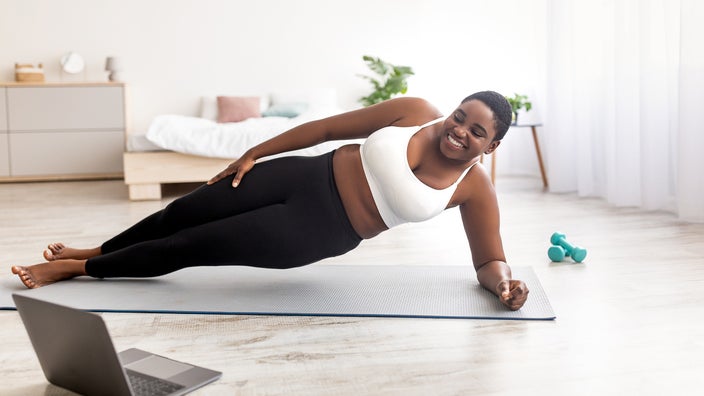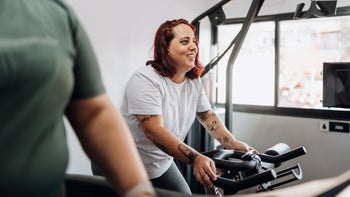
What Core Strength Exercises Can Improve My Health?
Key takeaways:
The core includes all the muscles in the trunk — from the diaphragm to the pelvic floor.
Core-strengthening exercises can improve your functional mobility and lower your risk of injury.
You can do core-strengthening exercises at any fitness level and with minimal equipment.

When you think of exercises to strengthen your core, sit-ups –– and washboard abs –– may come to mind. But your core is not just your abdominals. It also consists of a group of muscles that support your back. And core-strengthening exercises can do much more than give you defined abs.
Having a strong core can improve your functional mobility and lower your risk of injury. So the best core-strengthening moves should target multiple muscle groups. If you're tired of doing sit-ups and crunches, we've got you covered. Keep reading to find out how to strengthen your core, including five different exercises you can try.
Where is your core?
Trainers, coaches, and healthcare professionals often mention the importance of a strong core. But you may not be entirely sure which parts of your body make up your core.
Search and compare options
The core refers to all the muscles in your trunk or torso. Some of the main muscles include:
Diaphragm: A muscle at the base of your lungs that helps you breathe.
Rectus abdominis: These "six-pack" muscles in the center of your abdomen help you bend forward.
Internal and external obliques: The muscles on the sides of your abs allow you to twist or bend your torso.
Transverse abdominis: This deep core muscle wraps around your torso and stabilizes your trunk.
Trapezius: The trapezius is a large muscle that extends from the back of your head to your neck, shoulders, and back. It stabilizes your posture and helps you do things like turn your head from side-to-side or shrug your shoulders.
Multifidus: These deep back muscles support your spine and protect your back from injury.
Latissimus dorsi: The latissimus dorsi, or lats for short, is a large back muscle that helps with upper body movements like chin-ups. It’s also involved in respiratory processes like deep breathing.
Erector spinae: These spinal extensors help you make movements like standing up after bending over.
Pelvic floor muscles: These muscles at the base of your core support pelvic organs, including the bladder and bowel.
These and other core muscles –– such as the glutes, hip flexors, and hip adductors –– are important for your health and functional mobility, especially as you get older.
What are the benefits of a strong core?
Think of your core as a centerpiece connecting your upper and lower body. It serves as an anchor for your limbs, stabilizes your spine, and is essential for nearly every movement you make. The more stable your core is the better you can transfer energy to your arms and legs as you walk, run, or lift.
There are numerous benefits of having a strong core. It can:
Improve balance and stability: A strong core can improve balance and stability, which may help prevent falls.
Lead to better posture: Strong core muscles can help you maintain an upright posture and avoid slouching.
Make everyday activities easier: The stronger your core, the more strength and power you have for everyday activities like carrying groceries, doing yard work, and climbing stairs.
Reduce your risk of low back pain: Low back pain will affect nearly 80% of adults at some point in their lifetime. Luckily, core-stability exercises can lessen symptoms of chronic low back pain.
Prevent injuries: Studies show that core-strengthening programs can improve lower limb function, which may lower the risk of sports- or work-related injuries.
Improve your breathing efficiency: A strong core builds your diaphragm, which is the muscle involved in breathing.
Lower the risk of incontinence: The pelvic floor, which is part of the core, supports the pelvic organs and helps manage symptoms of urinary incontinence.
Read more like this
Explore these related articles, suggested for readers like you.
5 core-strengthening exercises you can do anywhere
The good news is that you don’t need a gym or expensive equipment to do core-strengthening exercises. You can build your core muscles at any fitness level using your body weight or minor equipment.
Here are five core-strengthening exercises you can do anywhere.
Heel Slides
Heel or leg slides are a good introductory core exercise for beginners. The key is to move as slowly and controlled as possible.
Lie on your back either on a mat or towel positioned on a bare floor (no rug). Wear socks to help with sliding.
Bend your knees to 90 degrees and place your feet flat on the floor.
Inhale, drawing your belly button to your spine, then exhale as you slowly slide one foot away from your butt until your leg is extended straight.
Draw your leg back in towards your butt until your knee is bent to 90 degrees again. Be sure to keep your abs engaged and your belly button drawn into your spine.
Switch legs.
Complete 30 reps per leg. Move as slowly as possible.
Dead Bug
Sure, it has a weird name. But the dead bug encourages core stability by strengthening your lower abs and pelvic floor muscles.
Lie on your back with your knees bent to 90 degrees, shins parallel to the floor, and arms pointing straight up towards the ceiling.
Engage your abs, while keeping your lower back on the floor.
Slowly lower your right leg until your heel almost touches the floor. At the same time, extend your left arm back towards the floor without touching it.
Lift your right leg and left arm back to the starting position.
Repeat the move with the opposite arm and leg.
Switch sides with each rep until you complete 15 reps per side.
As you get stronger, you can use ankle weights for added resistance.
Forearm Plank
Some people have a love-hate relationship with planks. But no matter how you feel about them, this challenging move can be very effective. It's a great core-strengthener because it targets the muscles in your abs and spine to help with stability.
You can modify planks based on your current fitness level. To do a forearm plank:
Get down on all fours. Bend your arms to support your weight on your forearms. Your elbows should be directly underneath your shoulders.
Step both legs back, so only your forearms and toes are touching the ground. Your feet should be hip-width apart.
Squeeze your glutes and engage your abs by drawing your belly button up to your spine. Your body should be in a straight line from your head to your feet.
Hold the pose for 30 to 60 seconds.
As with any exercise, proper form is key. While doing planks, remember not to drop your head or your hips. Listen to your body and relax out of the position when your form starts to break down.
Bird Dog
This core-strengthening exercise stretches your spine. The bird dog can improve stability and posture and reduce the risk of lower back pain.
Get in a tabletop position by kneeling on all fours with a flat back and wrists under your shoulders.
Engage or tighten your abs. Keep your neck and spine in a neutral position.
Extend your right arm and left leg simultaneously and keep your balance steady. Your arm should be straight forward and your leg should be straight back. Both should be parallel to the floor.
Hold the position for a few seconds before returning to the starting position.
Repeat the move with your left arm and your right leg.
Continue switching sides until you've done a total of 30 reps.
Bulgarian Split Squat
Bulgarian split squat is a total-body move that strengthens your quads, hips, glutes, and hamstrings. If you don't have a dumbbell for this move, you can also use household items like a 12 oz or 16 oz can.
Stand about two feet in front of a stable bench or box that's knee level, with your back toward it and your legs shoulder-width apart.
Use both hands to hold a dumbbell or weighted object in a vertical position in front of your chest. Keep your elbows close to your sides.
Extend your left leg back, and place your foot on the bench so that the laces of your shoes touch the bench.
Engage your core and slowly lower into a lunge by bending both knees. Your left knee should hover just above the floor without touching it.
Push your right foot into the floor to stand up and return to the starting position.
Switch legs and complete 15 reps per side.
Beginners can try the move with both feet on the floor instead of elevating the rear foot.
The bottom line
Your core consists of muscles in your trunk, including your diaphragm, abs, and pelvic floor. It protects your spine and is critical for your health and mobility. Fortunately, anyone –– from beginners to trained athletes –– can do core-strengthening exercises to improve posture and functional mobility, and lower the risk of injury.
Why trust our experts?



References
American Council on Exercise. (n.d.). Bird-dog.
American Council on Exercise. (n.d.). Bulgarian split squat.
American Council on Exercise. (2013). Core anatomy: Muscles of the core.
Better Health Channel. (2015). Abdominal muscles. Department of Health, State Government of Victoria, Australia.
Cavaggioni, L., et al. (2015). Effects of different core exercises on respiratory parameters and abdominal strength. Journal of Physical Therapy Science.
Dumoulin, C., et al. (2020). Group-based vs individual pelvic floor muscle training to treat urinary incontinence in older women. JAMA Internal Medicine.
Eickmeyer, S. M. (2017). Anatomy and physiology of the pelvic floor. Physical Medicine and Rehabilitation Clinics of North America.
Frizziero, A., et al. (2021). Efficacy of core stability in non-specific chronic low back pain. Journal of Functional Morphology and Kinesiology.
Hsu, S. L., et al. (2018). Effects of core strength training on core stability. Journal of Physical Therapy Science.
Jeno, S. H., et al. (2021). Anatomy, back, latissimus dorsi. StatPearls.
Kang, K. Y. (2015). Effects of core muscle stability training on the weight distribution and stability of the elderly. Journal of Physical Therapy Science.
Kovar, E. (2014). Core-strengthening exercises that help with back injury rehab. American Council on Exercise.
Manjusha, K., et al. (2021). The effectiveness of core strength training to improve functional mobility and balance in geriatric population: A literature review. Orthopedic Research Online Journal.
Mullane, M., et al. (2019). Exercise technique: The dead bug. Strength and Conditioning Journal.
Oliva-Lozano, J. M., et al. (2020). Core muscle activity during physical fitness exercises: A systematic review. International Journal of Environmental Research and Public Health.
Ourieff, J., et al. (2021). Anatomy, back, trapezius. StatPearls.
Peate, W. F., et al. (2007). Core strength: A new model for injury prediction and prevention. Journal of Occupational Medicine and Toxicology.
Sasaki, S., et al. (2019). Core-muscle training and neuromuscular control of the lower limb and trunk. Journal of Athletic Training.





























